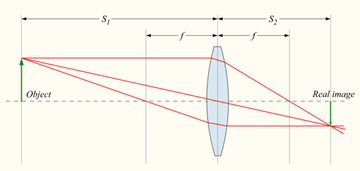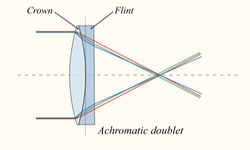Refracting telescopes use lenses - doubly-curved pieces of glass or another transparent material - to focus light. This has the effect of brightening an image, magnifying it, and improving the available angular resolution. A single lens will produce a clear, in-focus image at a point that depends on its focal length, as shown by the equation below.


For nearby objects, the position of the focused image S2 changes depending on the distance of the object. What happens when the object is very far away, essentially at infinity?
The magnification of the telescope is determined by both the focal length of the objective lens, fo, and the focal length of the eyepiece, fe.

A problem encountered with refracting telescopes is that glass lenses bend light differently depending on frequency. This causes an effect called chromatic aberration, in which the colors in the image are distorted and out of focus. The effect can be corrected for by combining two lenses of slightly different refractive indices. One lens is converging, the other diverging. The dispersion in one lens is canceled out by the dispersion of the other, and light of different colors is combined properly at the focal plane.
